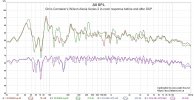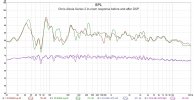Lot's of good discussion in this thread...thanks everybody.
And of course thank you Mitch for the opening post/presentation. Has a well laid out logical sequence, is quite instructive, and with supporting links....nice work

I have not yet tried any form of automated room correction, so seeing examples of the Acourate and Audiolense workflow has been very helpful.
I do have substantial experience with FIR, having used it to tune dozens of DIY speaker builds.
The tunings have been for speaker-only with no consideration of what room they might go in; outdoor quasi-anechoic measurements, spinorama type, on and off axis optimizations.
Most of the builds have been 3 or 4-ways for use with a sub, and have all used a FIR-tuned amplification channel for each 'way'. So lot's of FIR files to say the least....
Usually linear phase tunings, but sometimes IIR when latency doesn't work (live sound applications).
It's been interesting to contrast the "digital room correction" procedure presented, to the "digital speaker correction" procedure I've come to use.
Without a room to consider, there's been no need to to divide the frequency spectrum into the Normal Modes, Diffusion, and Absorption ranges that each use varying DSP approaches. (Lot's for me to learn here)
I simply work to get mag and phase as smooth and flat throughout the spectrum as possible; with smooth directivity curves.
There is also contrast as to what degree of correction to apply in terms of the smoothing level to correct (at least in my mind

My approach has been to correct any magnitude ripples that respond well to minimum phase correction, and that hold up both on and off axis. Very clean builds that show relatively few multiple-arrival paths to the mic, often hold up well even to corrections made with just 1/24th smoothing. Whereas builds that show more multiple-arrival paths, only hold up to say 1/3 to 1/6th smoothing.
Whether to tune to a single measurement, or multiple measurements, is an open issue outdoors for me still and has depended build by build. Although obviously not nearly the size of the issue indoors
I call this SOMA...(State of MY Art)...........a term i wished everyone would use in place of SOTA, (State of THE Art),
Hearing SOTA always puts me on get-wary alert. (My only humble criticism with your preso, Mitch.)
Anyway, I can totally understand the back and forth in this thread about how much correction, and how to go about it, once inside a room.
My approach to date has been to build the best speaker i can quasi-anechoically.
Then, if i don't like the way it sounds in a room; first take care of the room's RT60 curve, and then play with speaker placement along with direct reflection/diffusion treatments based on placement.
Only EQ use has been to curb sub modes, or make a down sloping house-curve preference (with i do with global shelving on the input signal).
So an old school approach other than the (mainly linear phase) FIR tuning.
Here's one puzzler i have about what's been shown with the room correction procedure.....
It seems it relies on a speaker passing a certain level of anechoic correctness, before beginning.
One of the points made several times was the reliance on Psych smoothing for DRC (which makes total sense to me, knowing the dangers of overcorrection to a spot.)
If i just used Pych smoothing for making outdoor tunings/correction, I'm leaving a lot of speaker goodness on the table.
Finer quasi-anechoic mag and phase performance is easily accomplished, before bringing it indoors. I can hear this outdoors, comparing differnt degrees of mag and phase correction.
What do you consider the signs that a speaker itself needs more correction before beginning your room integration process?
And a second question if i may...which DRC software would best accomplish both driver-by-driver, DIY speaker-builder corrections, along with subsequent room corrections? It appeared that may be Audiolense??
thx, mark


